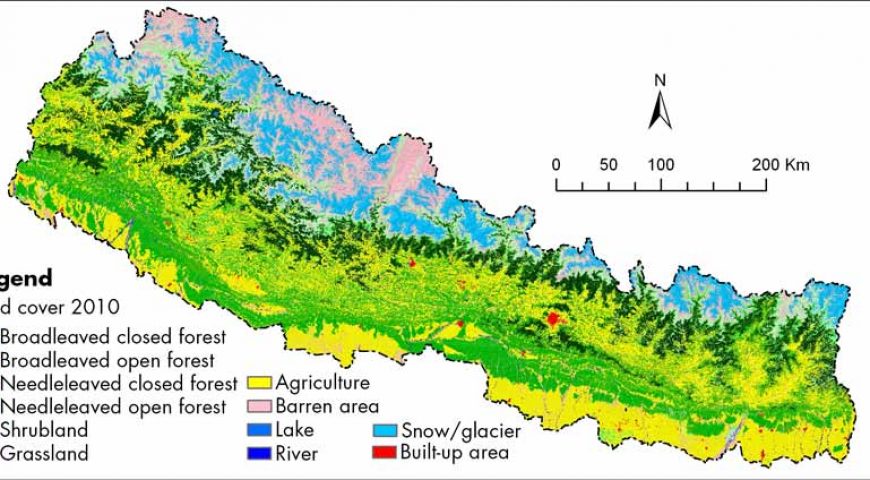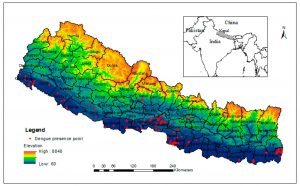
Climate of Nepal
Climatic conditions of Nepal vary from one place to another in accordance with the geographical features. In the northern summers are cool and winters severe, while in south, summers are tropical and winters are mild. Nepal has namely five major seasons: spring, summer, monsoon, autumn and winter. An average temperature drop of 6°C occurs for every 1,000 m gain in altitude. In the Terai, summer temperatures exceed 37° C and higher in some areas, winter temperatures range from 7°C to 23°C in the Terai. In mountainous regions, hills and valleys summers are temperate while winter temperatures can plummet under subzero. The valley of Kathmandu has a pleasant climate with average summer and winter temperatures of 19°C – 35°C and 2°C – 12°C respectively. The Himalayas act as a barrier to the cold winds blowing from Central Asia in winter, and forms the northern boundary of the monsoon wind patterns. Eighty percent of the precipitation is received during the monsoon (June-September). Winter rains are more pronounced in the western hills. The average annual rainfall is 1,600 mm, but it varies by eco-climatic zones, such as 3,345 mm in Pokhara and below 300 mm in Mustang. An interesting fact is that there is no seasonal constraint on traveling in and through Nepal. Even in December and January, when winter is at its severest, there are compensating bright sun and brilliant views. As with most of the trekking areas in Nepal, the best time to visit are during spring and autumn. Spring is the time for rhododendrons while the clearest skies are found after the monsoon in October and November. However, Nepal can be visited the whole year round.
Source:Nepal Tourism Board (NTB)
For more information about Nepal’s climatic conditions, please visit: http://www.dhm.gov.np (official web site of the Department of Hydrology & Meteorology, Ministry of Environment).

Weather
Nepal has four seasons such as autumn (Sep. Nov. and Oct.), winter (Dec. Jan. and Feb.), spring (March, April and May) and monsoon (June, July, and Aug.). During the autumn season the nights are cold in the mountains, but the bright sun makes for pleasant daytime temperatures. At a higher altitude, temperature range from about 20°C down to perhaps -10°C at night. Morning is usually clear, and then clouds build up during the afternoon, disappearing at night to reveal spectacular starry skies.
During the winter season high passes, especially the Thorong-la pass on the Annapurna circuit trekking, Ganjala pass, Chola Pass, Renjola Pass, Khongmola pass, Lauribina pass, Gosaikunda pass are usually closed. Short and easy trek in middle hills is the best at this time. Heavy snowfalls does especially during the January, February and March in mountain areas.
Spring season brings warmer weather, but more frequent storms and considerable snowfall at higher altitude. Birds and flowers, especially rhododendrons, are seen at the lower altitudes. Toward the end of March, haze-caused by dust from the plains of India and smoke from local fires often obscure distant views. In addition, it becomes much warmer in the region below 3000 ft.
Trekking in Monsoon (June to Aug.) can be undertaken by the keen or experienced. Rain, mist and fog can be expected almost daily, but clouds part occasionally to give spectacular views of the mountains. The floors are usually at their most colorful. Leeches abound in middle elevation forests. Mountain weather is highly unpredictable. Classic signs of a storm approaching, such as cirrus clouded sky, or a fall in barometric pressure, can be misleading.
Best time for trekking in Nepal is autumn (September, October-November) and spring (March, April and May). Short treks and some Tea Houses treks can be done during winter or summer season as well. You need to be prepared for sudden weather changes while trekking. That’s why trekking equipment should be chosen carefully before the trip. Sudden rain storms or snow are always a possibility which needs to be considered. The weather during the trekking season is somewhat more stable. “Asian Hiking Team” pays big attention to weather forecasts.
